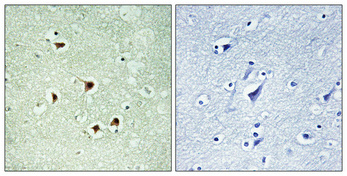Max (phospho Ser2) Polyclonal Antibody
- Catalog No.:YP1009
- Applications:IHC;IF;ELISA
- Reactivity:Human;Mouse;Rat
- Target:
- Max
- Fields:
- >>MAPK signaling pathway;>>Pathways in cancer;>>Transcriptional misregulation in cancer;>>Small cell lung cancer
- Gene Name:
- MAX
- Protein Name:
- Protein max
- Human Gene Id:
- 4149
- Human Swiss Prot No:
- P61244
- Mouse Swiss Prot No:
- P28574
- Rat Gene Id:
- 60661
- Rat Swiss Prot No:
- P52164
- Immunogen:
- The antiserum was produced against synthesized peptide derived from human MAX around the phosphorylation site of Ser2. AA range:1-50
- Specificity:
- Phospho-Max (S2) Polyclonal Antibody detects endogenous levels of Max protein only when phosphorylated at S2.
- Formulation:
- Liquid in PBS containing 50% glycerol, 0.5% BSA and 0.02% sodium azide.
- Source:
- Polyclonal, Rabbit,IgG
- Dilution:
- IHC 1:100 - 1:300. ELISA: 1:5000.. IF 1:50-200
- Purification:
- The antibody was affinity-purified from rabbit antiserum by affinity-chromatography using epitope-specific immunogen.
- Concentration:
- 1 mg/ml
- Storage Stability:
- -15°C to -25°C/1 year(Do not lower than -25°C)
- Other Name:
- MAX;BHLHD4;Protein max;Class D basic helix-loop-helix protein 4;bHLHd4;Myc-associated factor X
- Molecular Weight(Da):
- 18kD
- Background:
- The protein encoded by this gene is a member of the basic helix-loop-helix leucine zipper (bHLHZ) family of transcription factors. It is able to form homodimers and heterodimers with other family members, which include Mad, Mxi1 and Myc. Myc is an oncoprotein implicated in cell proliferation, differentiation and apoptosis. The homodimers and heterodimers compete for a common DNA target site (the E box) and rearrangement among these dimer forms provides a complex system of transcriptional regulation. Mutations of this gene have been reported to be associated with hereditary pheochromocytoma. A pseudogene of this gene is located on the long arm of chromosome 7. Alternative splicing results in multiple transcript variants. [provided by RefSeq, Aug 2012],
- Function:
- alternative products:Additional isoforms seem to exist,caution:The sequence shown here is derived from an Ensembl automatic analysis pipeline and should be considered as preliminary data.,function:Transcription regulator. Forms a sequence-specific DNA-binding protein complex with MYC or MAD which recognizes the core sequence 5'-CAC[GA]TG-3'. The MYC-MAX complex is a transcriptional activator, whereas the MAD-MAX complex is a repressor. May repress transcription via the recruitment of a chromatin remodeling complex containing H3-K9 histone methyltransferase activity.,PTM:Reversible lysine acetylation might regulate the nuclear-cytoplasmic shuttling of specific Max complexes.,similarity:Contains 1 basic helix-loop-helix (bHLH) domain.,subunit:Efficient DNA binding requires dimerization with another bHLH protein. Binds DNA as a heterodimer with MYC or MAD. Part of the E2F6.com-1 complex in
- Subcellular Location:
- Nucleus. Cell projection, dendrite .
- Expression:
- High levels found in the brain, heart and lung while lower levels are seen in the liver, kidney and skeletal muscle.
- June 19-2018
- WESTERN IMMUNOBLOTTING PROTOCOL
- June 19-2018
- IMMUNOHISTOCHEMISTRY-PARAFFIN PROTOCOL
- June 19-2018
- IMMUNOFLUORESCENCE PROTOCOL
- September 08-2020
- FLOW-CYTOMEYRT-PROTOCOL
- May 20-2022
- Cell-Based ELISA│解您多样本WB检测之困扰
- July 13-2018
- CELL-BASED-ELISA-PROTOCOL-FOR-ACETYL-PROTEIN
- July 13-2018
- CELL-BASED-ELISA-PROTOCOL-FOR-PHOSPHO-PROTEIN
- July 13-2018
- Antibody-FAQs
- Products Images

- Immunohistochemical analysis of paraffin-embedded Human brain. Antibody was diluted at 1:100(4° overnight). High-pressure and temperature Tris-EDTA,pH8.0 was used for antigen retrieval. Negetive contrl (right) obtaned from antibody was pre-absorbed by immunogen peptide.



